PSLV Launch Vehicle
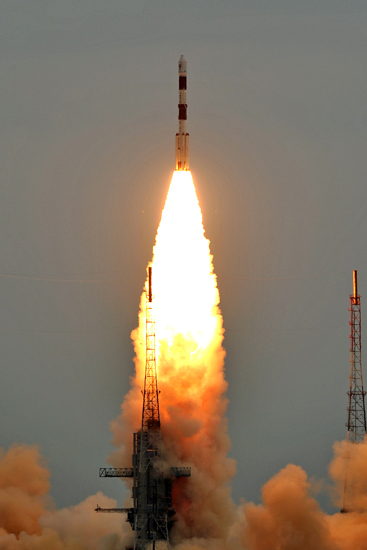
PSLV – The Polar Satellite Launch Vehicle is an Indian expendable launch system developed and operated by the Indian Space Research Organisation. The launch vehicle is a medium lift launcher that can reach a variety of orbits including Low Earth Orbit, Polar Sun Synchronous Orbit and Geosynchronous Transfer Orbit. PSLV is operated from the Satish Dhawan Space Center located in Sriharikota on India’s East coast.
PSLV is a four-stage rocket that uses a combination of liquid fueled and solid fueled rocket stages. The vehicle can fly in three different configurations to adjust for mission requirements.
The Polar Satellite Launch Vehicle features six Strap-on Solid Rocket Boosters clustered around its first stage which itself is also solid-fueled. The second stage is liquid fueled while the third stage is a solid rocket motor. The Upper Stage of the PSLV uses liquid Propellant. The launcher stands 44.4 meters tall and has a diameter of 2.8 meters. Depending on the launcher’s configuration, PSLV weighs 229,000, 296,000 or 320,000 Kilograms.
In addition to the ‘regular’ PSLV version, it can fly in its Core Alone configuration, without the six Solid Rocket Boosters and less propellant in the tanks of its upper stage – a configuration used for missions that feature small payloads.
PSLV can also fly in a XL Version that launches with additional propellant in its Solid Rocket Boosters to increase payload capability.
| Type | PSLV |
| Versions | Regular, Core Alone, XL |
| Height | 44.5m |
| Diameter | 2.8m |
| Launch Mass | 229,000kg (CA) to 320,000kg (XL) |
| Mass to LEO | 3,250kg |
| Mass to GTO | 1,410kg |
| Mass to SSO | 1,600kg – XL: 1,800kg – CA: 1,100kg |
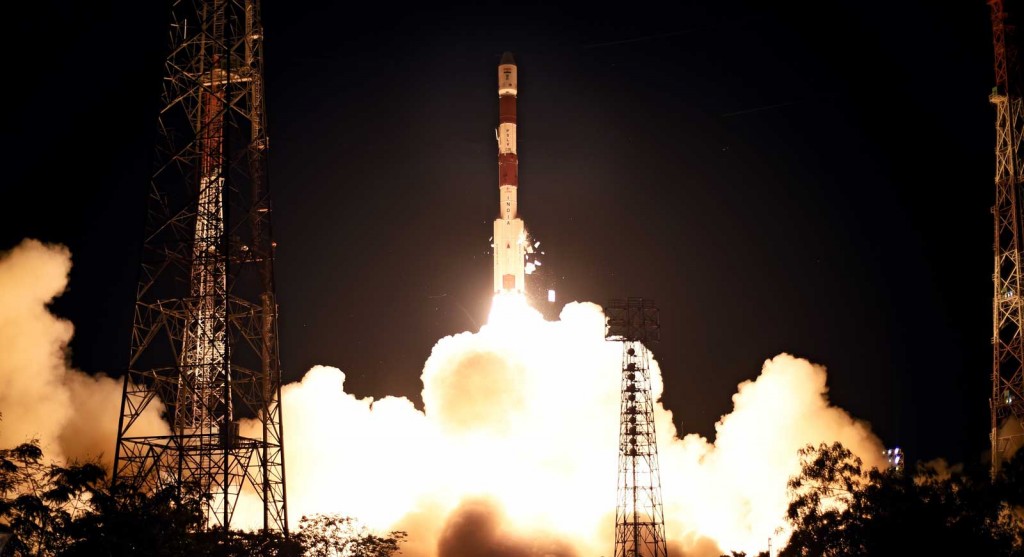
PSLV can deliver payloads of up to 3,250kg to Low Earth Orbit. Sun Synchronous capability is 1,600kg and Geosynchronous Transfer Orbit capability reaches 1,410 Kilograms.
PSLV was designed and developed by the Indian Space Research Organisation at the Vikram Sarabhai Space Center. PSLV made its first flight on September 20, 1993, but the mission failed early into flight when a large disturbance occurred at the point of second stage separation and one of the retro rockets of the second stage failed resulting an error in the flight control software of the vehicle.
The vehicle fell back to Earth and crashed in the Bay of Bengal about 12 minutes after launch. The second flight of the launcher was performed 13 months later after modifications were made to the vehicle. PSLV D2 successfully achieved orbit, placing the IRS P2 Remote Sensing Satellite in a 820-Kilometer Sun Synchronous Orbit.
One more successful development flight followed in 1996 before regular flights of the PSLV became available. The first operational flight of the vehicle came in 1997, but did send the IRS 1D payload into an elliptical orbit instead of a circular Sun Synchronous trajectory, requiring the satellite to perform orbit adjustments to meet its mission objectives. The flight was recorded as partial failure.
PSLV Rocket Configurations – Core Alone, Regular & XL
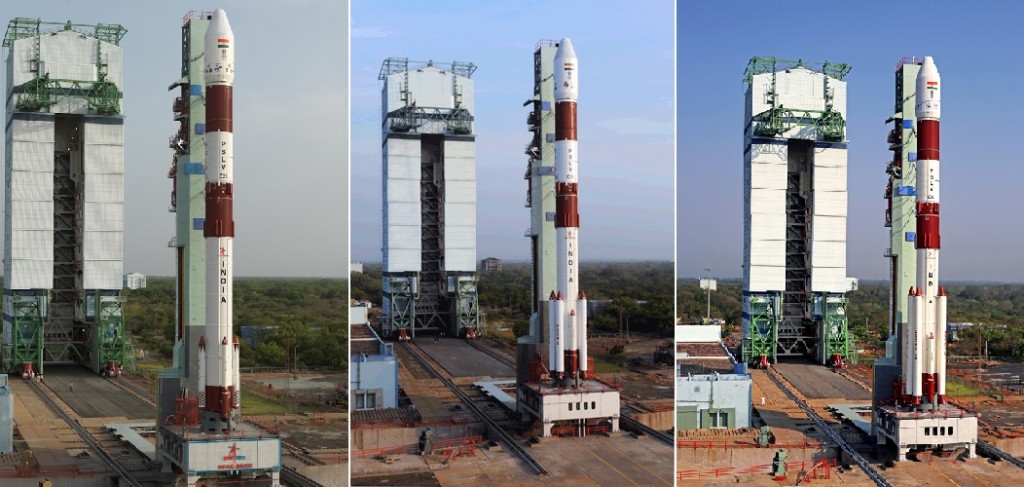
First Stage
| Type | PS1 |
| Inert Mass | 30,200kg |
| Launch Mass | 168,200kg |
| Diameter | 2.8m |
| Length | 20.34m |
| Propellant | Solid – HTPB Based |
| Fuel Mass | 138,00kg |
| Propulsion | PS1 Solid Rocket Motor |
| Thrust (Vacuum) | 4,860kN |
| Impulse | 269s |
| Burn Time | 105sec |
| Restart Capability | No |
| Attitude Control | SITVC (Pitch&Yaw), Roll RCS |
| Stage Separation | Flexible Linear Shaped Charge |
| Separation Motors |
The first stage of the PSLV, PS1, is a solid fueled rocket stage – one of the largest solid rockets ever flown, behind the Space Shuttle’s Solid Rocket Boosters and the Ariane 5 EAPs. It is 20.34 meters long and 2.8 meters in diameter with an empty mass of 30,200 Kilograms. The stage contains 138,000kg of HTPB (Hydroxyl-terminated polybutadiene) bound propellant at liftoff. PS1 has a vacuum thrust of 4,860 Kilonewtons.
First stage attitude control is provided by a Secondary Injection Thrust Vector Control (SITVC) for yaw and pitch. For SITVC, Strontium Perchlorate is used as a secondary fluid that is injected from the side into the Hypersonic Flow in the nozzle, causing a lateral thrust element that is precisely steered for attitude control. The SITVC fluid is stored in two cylindrical aluminum tanks strapped to the core stage. The tanks are pressurized with Nitrogen. Roll control is provided by two Roll Control Thrusters that are mounted radially on opposite sides of the core stage between the Solid Rocket Boosters.
The first stage burns for 105 seconds and is separated at an altitude of 76 Kilometers by a flexible linear shaped charge. Separation motors are used to ensure the first stage moves away from the second stage before it ignites.
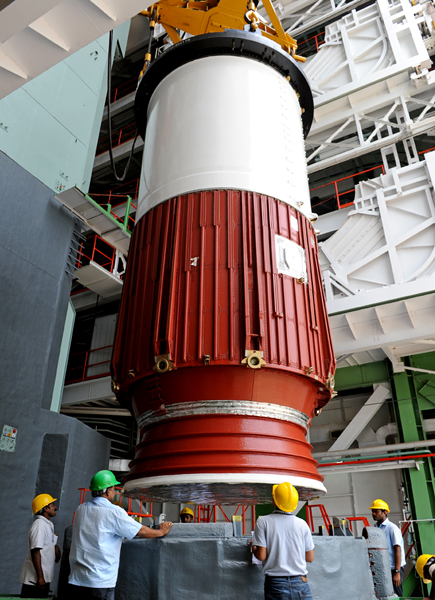
Solid Rocket Boosters
| # Boosters | CA:0 – Regular&XL:6 |
| Length | 10.0m (Regular), 13.5m (XL) |
| Diameter | 1.0m |
| Dry Mass | 2,010kg |
| Launch Mass | 11,000kg (Regular), 14,000kg (XL) |
| Propellant | Solid – HTPB Based |
| Fuel Mass | ~9,000kg (Regular), ~12,000kg (XL) |
| Thrust (Vacuum) | 502.6kN |
| Burn Time | 44sec (Regular) 49.5sec (XL) |
| Impulse | 262s |
| Attitude Control | SITVC on two Boosters |
| Stage Separation | Ball & socket joint, spring thruster |
PSLV in its standard and XL configuration uses six Solid Rocket Boosters, four are ignited on the ground and two boosters are air-lit. Each of the standard PSOM boosters has an empty mass of 2,010 Kilograms, is 1.0 meter in diameter and has a length of 10.0 meters. The boosters use nearly 9,000 Kilograms of HTPB propellant to provide a vacuum thrust of 503 Kilonewtons for a total burn time of 44 seconds. Two of the boosters of the vehicle have an SITVC system to provide roll control augmentation. The two air-lit boosters are usually ignited 25 seconds into the flight.
In the PSLV XL configuration, the PSOM-XL boosters are stretched to accommodate additional propellant for a longer burn time. PSOM-XL is 13.5 meters long and contains 12,000 Kilograms of solid propellant. The XL boosters have a burn time of 49.5 seconds.
The ground-lit Boosters separate at T+68 seconds at an altitude of 24 Kilometer while the air-lit boosters are jettisoned at T+90 seconds at an altitude of 41 Kilometers.
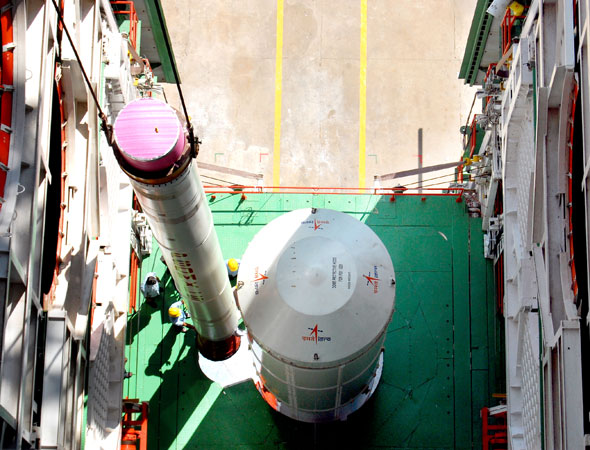
| Type | PS2 |
| Diameter | 2.8m |
| Length | 12.8m |
| Inert Mass | 5,300kg |
| Launch Mass | 46,000kg |
| Fuel | Unsymmetrical Dimethylhydrazine |
| Oxidizer | Nitrogen Tetroxide |
| Propellant Mass | 40,700kg |
| Propulsion | 1 Vikas |
| Thrust | 799kN |
| Impulse | 293s |
| Engine Dry Weight | 900kg |
| Burn Time | 158sec |
| Chamber Pressure | 58.5bar |
| Mixture Ratio | 1.7 (Ox/Fuel) |
| Area Ratio | 31 |
| Prop Flow Rate | 278.04kg/s |
| Attitude Control | Main Engine Gimbaling, Roll RCS |
| Stage Separation | Merman Band, Sep Motors |
Second Stage
The second stage of the PSLV rocket is 2.8 meters in diameter, 12.8 meters long and has a liftoff mass of 46,000 Kilograms with an empty mass of 5,300 Kilograms.
The stage uses Unsymmetrical Di-Methylhydrazine / Hydrazine Hydrate as fuel and Nitrogen Tetroxide as oxidizer. It is powered by a single 799-Kilonewton Vikas engine. Vikas was developed by ISRO in the 1970s.
The engine has a dry weight of 900 Kilograms and operates at a chamber pressure of 58.5 bar and provides a specific impulse of 294 sec.
The second stage burns for 158 seconds. Vehicle control during second stage flight is accomplished by gimbaling the main engine by up to 4 degrees, roll control is provided by a Hot Gas Reaction Control Motor.
Second stage separation is accomplished with a merman band system and separation motors. It occurs at an altitude of 277 Kilometers.
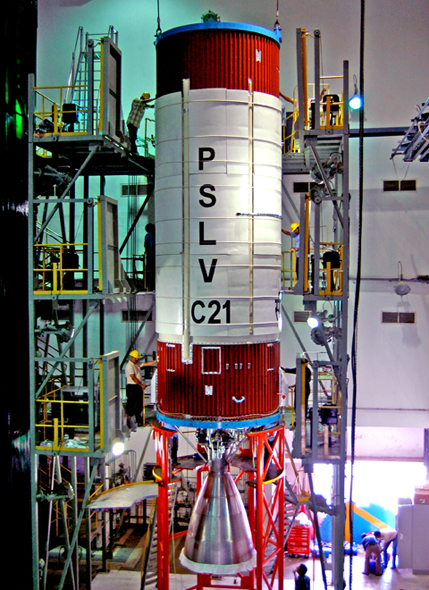
| Type | PS3 |
| Diameter | 2.02m |
| Length | 3.54m |
| Inert Mass | 1,100kg |
| Launch Mass | 7,800kg |
| Propellant | Solid – HTTP Based |
| Propellant Mass | 6,700kg |
| Propulsion | S-7 |
| Thrust | 244kN |
| Impulse | 294s |
| Burn Time | 112sec |
| Attitude Control | 4th Stage RCS |
| Separation | Ball Lock |
Third Stage
The PS3 stage is a solid rocket motor that also uses an HTPB based propellant. The third stage of the PSLV launcher has a reduced diameter of 2.02 meter and a length of 3.54 meters.
It has an empty mass of 1,100 Kilograms and a liftoff weight of up to 7,800 Kilograms. The stage has a burn time of 112 seconds during which it generates a thrust of 244 Kilonewtons.
The stage has a Kevlar-polyamide fiber case and a submerged nozzle equipped with a flex-bearing-seal gimbaled nozzle that can be gimbaled by up to 2 degrees for Thrust Vector Control. Roll control is provided by the Reaction Control System of the fourth stage. The third stage separates at an altitude of 580 Kilometers.
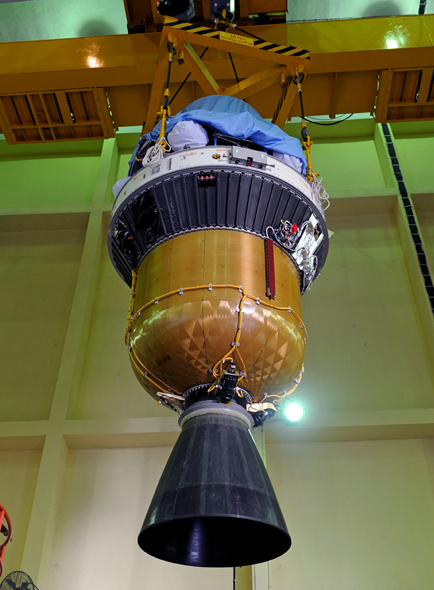
| Type | PS4 |
| Diameter | 2.02m |
| Length | 2.60m |
| Inert Mass | 920kg |
| Launch Mass | 2,920kg (Regular, XL), 2,520kg (CA) |
| Fuel | Monomethylhydrazine |
| Oxidizer | MON3 (Mixed Oxides of Nitrogen) |
| Propellant Mass | 2,000kg (Regular, XL), 1,600kg (CA) |
| Propulsion | 2 L-2-5 |
| Total Thrust | 14.6kN |
| Impulse | 308s |
| Chamber Pressure | 8.4bar |
| Engine Diameter | 0.66m |
| Burn Time | Variable, Up to 525sec |
| Area Ratio | 60 |
| Attitude control | Reaction Control System |
| Separation | Ball Lock |
Fourth Stage
The Upper Stage of the PSLV launcher is liquid fueled using Monomethylhydrazine fuel and Mixed Oxides of Nitrogen as an oxidizer. The stage is 2.02 meters in diameter and has a length of 2.60 meters with an empty mass of 920 Kilograms.
It contains 2,000 Kilograms of propellant when flying on the regular and XL configuration and 1,600 Kilograms when flying atop the CA configuration. The fourth stage is powered by two L-2-5 engines, each producing a thrust of 7.4kN and a specific impulse of 309 sec. The engines can be gimbaled by up to 3 degrees for pitch and yaw control while roll control is provided by the Reaction Control System. The RCS is also used during coast periods and to re-orient the vehicle for spacecraft separation. The fourth stage has a variable burn time depending on the mission profile. It can support burns of up to nine minutes.
The fourth stage also houses the Equipment Bay of the vehicle containing the inertial guidance system and flight computer (Vikram 1601) as well as telemetry and avionics equipment.
Payload Fairing
| Diameter | 3.2m |
| Length | 8.3m |
| Mass | 1,150kg |
| Separation | Piston Cylinder Mechanism |
| Clamp Band | |
| Construction | Aluminum Alloy, Semi Monocoque |
| Spherical Nose Cap, Forward | |
| Conical Section, Cylindrical Section, | |
| Conical Boat-tail |
The Payload Fairing, or “Heat Shield” as ISRO refers to it, is positioned on top of the stacked vehicle and its integrated Payload. It protects the spacecraft against aerodynamic, thermal and acoustic environments that the vehicle experiences during atmospheric flight. When the launcher has left the atmosphere, the fairing is jettisoned by pyrotechnical initiated systems. Separating the fairing as early as possible increases launcher performance.
The typical PSLV Payload Fairing is 3.2 meters in diameter, 8.3 meters long and weighs 1,150 Kilograms. It consists of two all-aluminum halves that consist of different section. On top, the fairing has a spherical nose cone and a conical section at the forward end. A long cylindrical and a short conical boat-tail follow. The conical sections are stiffened semi-monocoque structures and the cylindrical section is and integrally stiffened isogrid structure made up of three 1.5-meter panels.
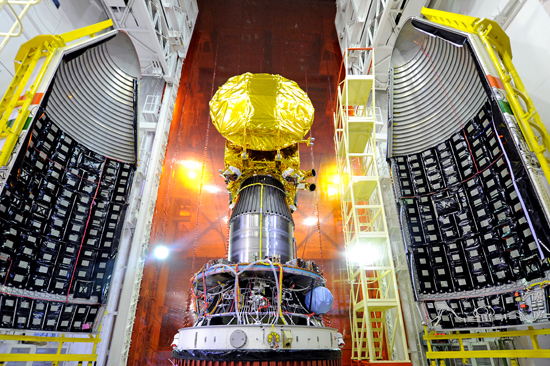
The payload fairing features a controlled environment and Payload purge supply as well as acoustic absorption blankets. Additionally, the fairing can be outfitted with RF windows.
The fairing is separated about 165 seconds into the flight at an altitude of 130 Kilometers. Separation is accomplished by a linear piston cylinder separation and jettisoning mechanism (zip cord) running along the full length of the PLF and a clamp and joint at the base of the fairing. Both systems are pyrotechnically initiated. The gas pressure generated by the zip cord expands a rubber bellow that pushes that piston and cylinder apart, pushing the fairing halves laterally away from the launcher.
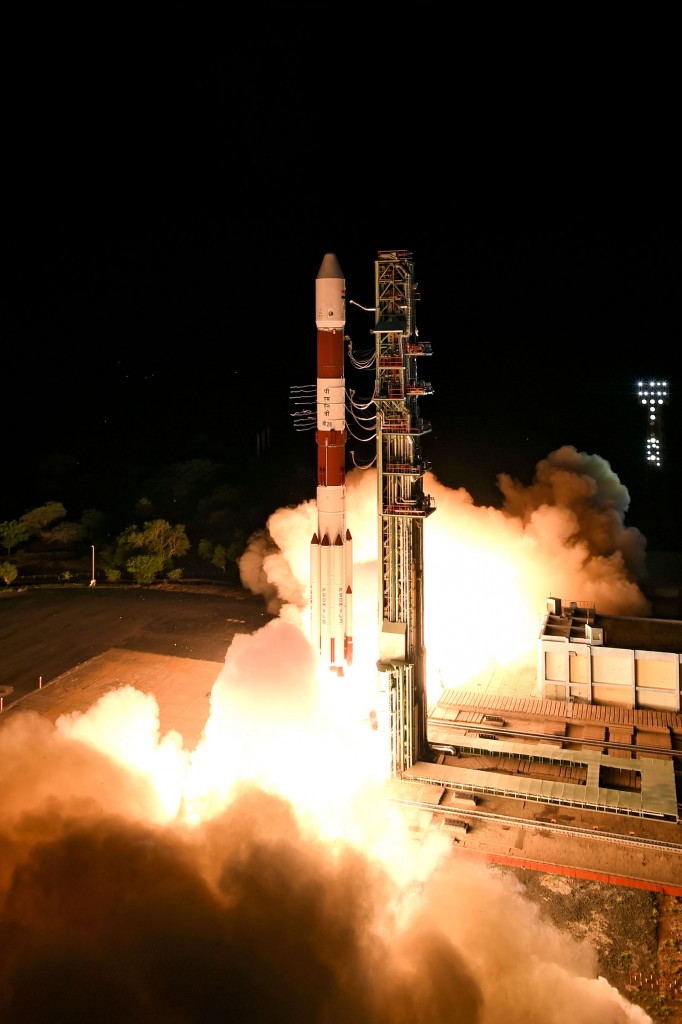
Payload Adapter
Payload Adapters interface with the vehicle and the payload and are the only attachment point of the payload on the Launcher. They provide equipment needed for spacecraft separation and connections for communications between the Upper Stage and the Payload.
The adapters feature the traditional clamp-band separation system, but low-shock options are available as well. The adapter is located on top of the fourth stage and Vehicle Equipment Bay. A number of standard adapters are available to accommodate a number of payloads, but payloads adapters can also be custom-built based on special payload requirements.
Auxiliary Payloads
PSLV is capable of carrying a number of secondary payloads into orbit via payload dispensers mounted on the vehicle equipment bay. These dispensers can either hold two satellites in the mass range of 50 to 150kg or more smaller satellites being released by small satellite deploying mechanisms. VEB is an annular deck plate made of Aluminium honeycomb panels, and mounted around the propellant tank of the Fourth Stage. Two plates are are installed on the VEB that serve as installation points for the payload accommodations that are located 180 degrees apart.
